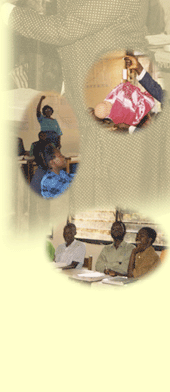
Essential Elements of Postabortion Care: An Expanded and Updated Model
In July 2002, the Postabortion Care (PAC) Consortium introduced Essential Elements of Postabortion Care: An Expanded and Updated Model. Based on a continuum of care approach, this model builds on the original PAC model, first articulated by Ipas in 1991 and published by the PAC Consortium in 1995. Program achievements and lessons learned with the original model, combined with commitments to the 1994 ICPD Program of Action, inspired the PAC/Community Task Force to develop a revised model that includes five essential elements of high-quality, sustainable PAC services:

Community and Service Provider Partnerships
To achieve universal local access to sustainable, high-quality PAC and other sexual and reproductive health services, community members, lay health workers, traditional healers and formally trained service providers must work in partnership. Components of this partnership include:
- Education to increase family planning and contraceptive use, prevent unwanted pregnancies and reduce unsafe abortion
- Participation in decisions about availability, accessibility and cost of services
- Promotion of client-centered, human rights-based services that meet community expectations, priorities and needs
- Education about obstetric emergencies and appropriate care-seeking behaviors
- Mobilization of community resources, including transportation, to ensure that women suffering from obstetric emergencies receive timely care
- Access to services for special populations of women including adolescents, women with HIV/AIDS, women who have experienced violence, women who have undergone female genital cutting, women who partner with women, refugees, prostitutes, and cognitively and physically disabled women
- Planning for sustainability.
Counseling
Effective counseling for women who are experiencing incomplete abortion and possible complications should begin with the first contact between the woman and her provider, and address broader emotional and physical health needs in addition to family planning and contraception. The aims of counseling are to:
- Provide emotional support throughout the postabortion visit
- Ensure that women are provided with appropriate information about medical conditions, test results, treatment and pain management options, and follow-up care, and that they understand how to prevent post-procedure complications and when and where to seek care for complications if they arise
- Help women clarify thoughts about pregnancy, incomplete abortion, treatment, resumption of ovulation and their reproductive health future
- Enable providers to better respond to other factors that could have an
impact on a client’s care—for example, gender-based violence and HIV/STIs.
Treatment of Incomplete and Unsafe Abortion
Emergency treatment has been the focus of many PAC activities. The rewording of this element in the new model recognizes that incomplete and unsafe abortion does not necessarily involve life-threatening complications and that treatment is therefore not always an emergency. Nonetheless, complications are potentially life-threatening without swift and appropriate medical attention. High-quality treatment includes manual vacuum aspiration (MVA) for uterine evacuation, standard infection prevention precautions, informed consent, appropriate pain management and follow-up care.
Contraceptive and Family Planning Services
Despite progress in the last decade, significant numbers of women who want to delay or avoid pregnancy or practice birth spacing are not using contraception. Access to a wide range of methods is an effective strategy for preventing unwanted pregnancies and unsafe abortions and helping women achieve their reproductive goals. Further, if women who do not desire pregnancy or are clinically advised against an immediate pregnancy are not offered contraceptive methods in the same facility following treatment, they may not return or follow-up on a referral for provision of a contraceptive method.
Reproductive and Other Health Services
Recognizing the breakdown in follow-up that frequently occurs with referrals, the expanded and updated model encourages providing selected reproductive and other health services at the same facility where women receive postabortion services. When it is not possible or appropriate for a facility to provide needed additional services, functional referral and counter-referral systems and follow-up mechanisms, including record keeping, should be in place to ensure that women’s needs are being met. Services offered might include:
- STI/HIV prevention education, screening, diagnosis and treatment
- Screening, treatment and referral for survivors of sexual and domestic violence
- Infertility diagnosis, counseling and treatment
- Nutrition and hygiene education
- Cancer screening and referral.
Seven years after the original PAC model was published, PAC Consortium members support a broader vision of high-quality PAC. By expanding from a facility-based, clinical services approach to a more comprehensive public health focus, the Essential Elements of Postabortion Care Model responds more effectively to women’s sexual and reproductive health needs and concerns. As programs based on the model are designed, implemented and evaluated, and our understanding of high-quality, sustainable PAC services is further informed, future revisions of the model are likely.
|











